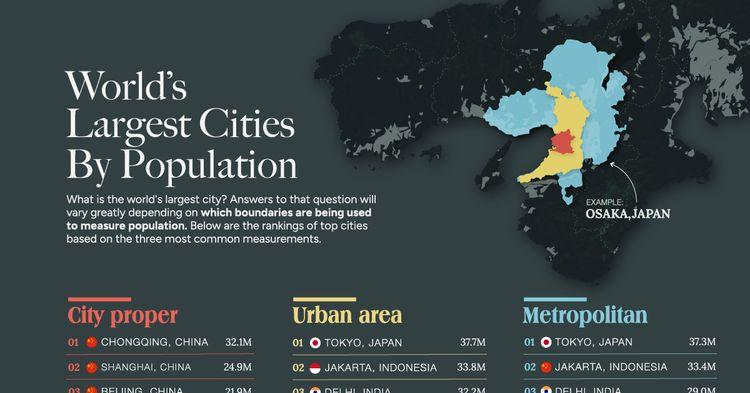Ranked: The World’s Largest Cities By Population

The Biggest Cities Worldwide
In the past hundred years, there has been a significant increase in urbanization across the globe.
Currently, over 4.3 billion individuals reside in city environments, accounting for approximately 55% of the global populace.
However, determining the world's largest city remains subjective as it relies on different criteria for establishing city limits and calculating their populations.
The image displayed above utilizes information obtained from the most recent official population surveys and estimates to categorize the leading cities according to the three most frequently used metrics.
Biggest Cities By Urban Area
Our initial measurement relies on the urban area itself, referring to the geographic limits set by the local government.
As per the United Nations, a city proper refers to "the solitary governing authority encompassing the historical nucleus of a city."
The Chinese metropolis of Chongqing takes the top spot in this measurement and has a governing territory that is as vast as Austria, accommodating a urban populace of 32.1 million people.
The monorail system in the city has achieved remarkable feats, such as being the lengthiest and most crowded in the entire world, encompassing an impressive 70 stations. Chongqing Jiangbei International Airport notably finds itself in the esteemed company of the 50 busiest airports worldwide. Moreover, this city has established its position as one of the top 50 global centers for scientific research.
This metric is primarily dominated by different cities in China.
The initial non-Chinese metropolis, Delhi, has been undergoing one of the swiftest urban augmentations globally.
According to estimates from the United Nations, India is anticipated to witness a significant increase in its urban population, with more than 400 million individuals expected to settle in cities by the year 2050. In comparison, China is projected to have approximately 250 million newcomers, while Nigeria is estimated to see around 190 million people migrating to urban areas.
Top Urban Cities
This calculation mainly disregards borders of land and regards a urban center as a continuous, linked developed region.
According to Demographia, urban regions serve as a cohesive economic entity, connected through the movement of commuters and various social and economic interactions.
According to this measure, Tokyo is in first place in the ranking.
Approximately 10% of Japan's population resides in the main city. However, when we take into account the broader Tokyo metropolitan area, which encompasses cities like Kanagawa, Saitama, and Chiba, the total population of Tokyo exceeds 37 million individuals. This accounts for approximately 30% of the entire population of Japan.
As a result, despite having one of the most extensive train networks globally, Tokyo's railway system is astonishingly packed, reaching a boarding capacity of 200% during rush hour in the most densely populated zones. Additionally, Tokyo boasts the renowned Shibuya Crossing, which holds the title of being the most bustling intersection worldwide.
Biggest Urban Areas
In terms of metropolitan area, Tokyo also takes the lead.
This metric bears resemblance to city regions and is typically determined and defined by authorized institutions, be it for statistical reasons or administrative matters.
In the US, this is represented by metropolitan statistical areas (MSAs), like Chicago-Naperville-Elgin or Phoenix-Mesa-Chandler.
With the ongoing increase in the global urban population, upcoming cities in Africa and Asia are anticipated to contend for the title of being the "biggest" in the near future.
According to the United Nations, it is estimated that by 2050, approximately 68% of the global population will reside in cities and towns.









































